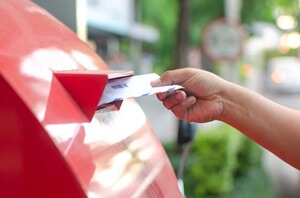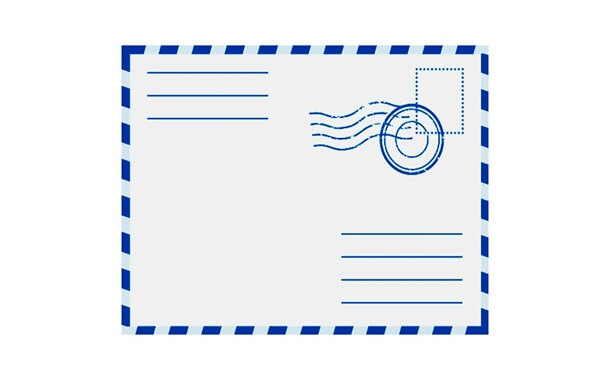How Much Does It Cost to Send a Letter?
Last Updated on April 16, 2024
Written by CPA Alec Pow | Content Reviewed by ![]() CFA Alexander Popinker
CFA Alexander Popinker
Sending personal correspondence through the mail in letters, greeting cards, postcards, and other documents remains a cherished way to stay in touch and communicate meaningful messages.
This guide will cover current standard postage rates under the United States Postal Service (USPS) and other carriers for domestic and international mail, tips and best practices for saving on mailing expenses, additional fees for enhanced security services, and everything you need to know to mail letters smoothly and affordably.
Let’s dive into the specifics of today’s postage prices and how to leverage the mail system expertly.
How Much Does It Cost to Send a Letter Through USPS?
For standard letter mail traveling within the 50 states and US territories, the USPS offers several main classes of mail service, each with different postage rates:
USPS First-Class Mail
- The most popular class for personal mail, First-Class starts at $0.63 for a standard 1-ounce letter measuring up to 6-1/8” x 11-1/2” in a standard #10 business envelope no thicker than 1⁄4 inch.
- Each additional ounce costs $0.21 extra with First-Class. So a 2-ounce letter would be $0.84, 3 ounces $1.05, etc.
- Letters over 1⁄4” thickness are considered “flats” and start at $1.16 for 1 ounce. Oblong shapes also fall under the flats category. Discounts are offered for presorting standard-size flats.
- Postcards cost $0.44 to mail with a First-Class stamp and count as flats.
- Forever Stamps can be used to mail 1-ounce First-Class letters and are currently valued at $0.63, but cover future postage increases.
USPS Marketing Mail
- For bulk advertising mail, Marketing Mail starts at $0.212 per item for standard letters and flats.
- Substantial presort discounts are offered for large-volume mailings starting at 200+ pieces.
- Marketing Mail takes longer for delivery with a maximum 21-day window.
Special Bulk Stamp Options
- “Additional Ounce” Stamps sold in packs economically handle extra letter weight.
- Denominated Bulk Mail Stamps such as 5-cent Stamps offset costs in bulk.
- Non-Profit stamps include an added donation to charity at no extra cost to user.
According to DoNotPay, for example, the cost of sending a letter through the US Postal Service (USPS) can range from $0.36 for a postcard to $22.75 for Priority Mail Express International. The specific cost depends on the mail class, with options such as First Class Mail, Priority Mail, and Priority Mail Express available. The size and weight of the letter also affect the cost, with larger or heavier letters requiring more postage.
SuperMoney provides a detailed breakdown of the cost of different types of mail, including letters, large envelopes, and postcards. For example, a first-class mail letter with one ounce of weight costs $0.60, while a postcard costs $0.44. Priority Mail and Priority Mail Express have higher costs, with flat-rate envelopes costing up to $27.50 and $27.10, respectively.
Towne Mailer notes that the cost of sending a letter in a window envelope is less than $1, while the cost of first-class mail is around $0.58. The website also highlights the benefits of using window envelopes, which can save money by avoiding the need to print the address on the envelope insert.
So, for standard personal letters, First-Class starting at $0.63 for 1 ounce or using Forever Stamps is the most economical for mail within the country. Adding extra services will increase the rates as detailed below.
International Postage Prices
Mailing items overseas to other countries comes at a higher premium given the added transportation effort, security, and potential customs requirements:
Canada and Mexico Mail
- Standard 1-ounce letters to Canada or Mexico start at $1.40 postage using USPS Global Forever Stamps.
- Flats/large envelopes are a minimum of $3.20 for the first ounce.
- Postcards are $1.40 just like regular letters.
- Additional ounces run $0.25 per ounce, so a 2-ounce letter would be $1.65 for example.
Other International Destinations
- For all other foreign countries, 1-ounce letters start at $1.40 postage but prices range higher depending on the exact destination region and delivery speed.
- Broadly, developed allies like Western Europe range on the low end from $1.40 to $1.60 while remote regions may exceed $2 per ounce.
- Large letter envelopes/flats to foreign countries start at around $3.20 and often go over $5 for initial ounces.
- Global Forever Stamps at $1.40 simplify international postage, automatically covering any rate increases in future years too.
- Strict customs forms, packaging, and content restrictions apply when mailing to many countries internationally which adds complexity.
The USPS website provides postage calculators to determine exact current rates by country, weight, and mail type. Rates and forms are updated frequently.
Costs for Extra USPS Services
Adding enhanced services to your letter mail through USPS and private carriers tacks on additional fees to handle items securely:
USPS Certified Mail
- Certified Mail starting at $4.10 provides mailing receipt confirmation, including electronic verification of delivery or attempted delivery. This allows you to track the letter’s status.
- Each additional ounce is $1.65 extra. Return Receipt add-on is $3.10 more.
- Certified Mail is recommended for important legal documents requiring proof of mailing or delivery.
USPS Registered Mail
- Registered Mail ranges from $13.75 to $19.95 depending on value, providing maximum postal security, insurance, chain of custody, and restrictions on who can receive the item.
- Used primarily for very sensitive documents like college transcripts, deeds, stocks, etc. where utmost tracking is needed.
- Available for international shipping as well.
You might also like our articles on the cost of a stamp, a postage meter, or a postal card.
USPS Return Receipt
- For any class of mail, Return Receipt for $3.10 mails back a postcard signed by recipient to confirm delivery.
Signature Confirmation
- Having the recipient’s signature collected at the delivery point costs $2.90 per piece.
Other Options
- Tracking for $0.80+ per piece
- Restricted Delivery for sensitive content
- Insurance against loss or damage
So for particularly important, confidential, or high-value mail, these extra protections provide security, proof, and peace of mind at reasonable rates.
Practical Tips and Best Practices
 Here are some tips and best practices for saving on mailing costs and ensuring your letters and packages avoid delays and problems en route to the recipient:
Here are some tips and best practices for saving on mailing costs and ensuring your letters and packages avoid delays and problems en route to the recipient:
Buy Stamps in Bulk
- Purchasing 1 ounce Forever or Global stamps in bulk from USPS or online sellers cuts per-unit costs.
- Additional Ounce stamps in 20 or 100 packs save versus buying individually.
Leverage Online Postage Savings
- Services like Click-N-Ship allow buying and printing postage directly on envelopes while offering discounts.
- You can also order Global Stamps in bulk online. PC Postage vendors provide savings too.
Know Your Postal Rates and Classes
- Compare Priority Mail vs First-Class pricing for packages and flats to find the most cost-efficient option.
- Use USPS postage calculators online to determine exact rates by destination, weight, and speed.
Follow Addressing Best Practices
- Fully complete return address info, recipient address, apartment numbers and proper formatting.
- Validate addresses through USPS tools to catch errors.
- Print clearly in all capital letters to avoid illegibility.
Weigh and Measure Before Mailing
- Weighing letters and packages ensures you apply enough postage to avoid return fees.
- Measure envelope dimensions so you select the proper letter vs. flat/parcel rates.
Explore Presort, Barcoding Discounts
- For bulk business mailings, presorting by zip code and barcoding can drive significant savings.
So by applying tips like buying Forever Stamps in bulk, using online postage, weighing accurately, and learning the nuances of USPS mail classes, you can contain costs while mailing efficiently and securely.
Final Words
The costs and processes for mailing letters through the US Postal Service, United Parcel Service (UPS), FedEx, and other carriers continues evolving. But following best practices for efficient mailing while leveraging cost-saving techniques can keep your postage budget under control.
Remember, standard USPS First-Class 1-ounce letters within the US cost $0.63, while International Global Forever postage starts at $1.40. Heavier letters, flats, and parcels incur higher fees per ounce. Extra services like Certified Mail, Tracking, and Signature Confirmation provide added security at reasonable rates.
Be sure to properly weigh and measure mail items, verify addresses, use online postage discounts, and request presort discounts for large business mailings.
Following current postal regulations and rates ensures your important personal and business letters reach their intended recipients in a timely, secure fashion while avoiding unnecessary added expenses. With the right techniques and some careful research into pricing structures, the mail system remains an effective way to make meaningful personal connections and communications.
Frequently Asked Questions
What is the cheapest way to mail a letter?
For standard US letter mail under 1 ounce, buying single Forever Stamps in bulk quantities is the most cost-effective method. Setting up a small business account with USPS also provides access to lower commercial base pricing.
Can you legally send mail without postage?
No, sending a letter through the US Mail without proper certified postage applied is against federal postal regulations. The recipient may receive a bill for return postage due if they accept delivery of underpaid mail. Never attempt to bypass proper postage.
Is it allowable to mail currency or checks?
Yes, you can safely send reasonable amounts of paper currency, personal checks or money orders enclosed within a standard letter or card. But always use security measures like Certified Mail or Registered Mail to minimize any risk, and notify the recipient cash is enclosed.



Leave a Reply
Want to join the discussion?Feel free to contribute!